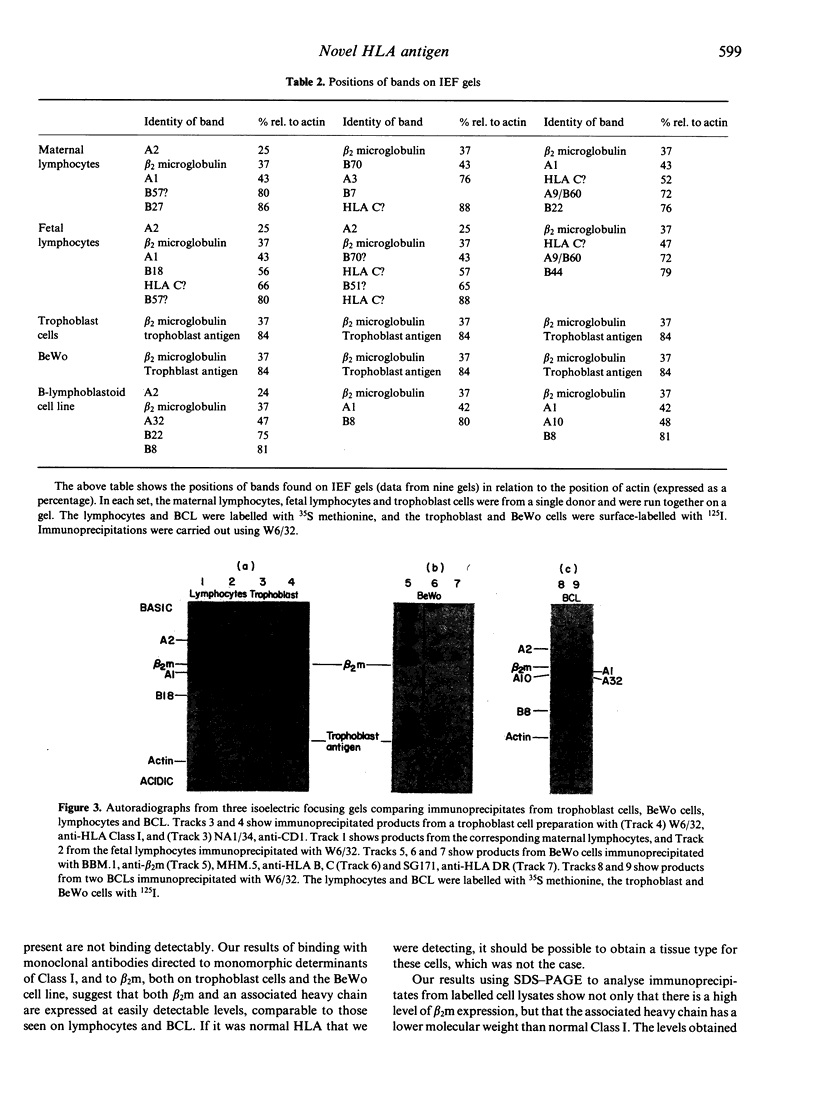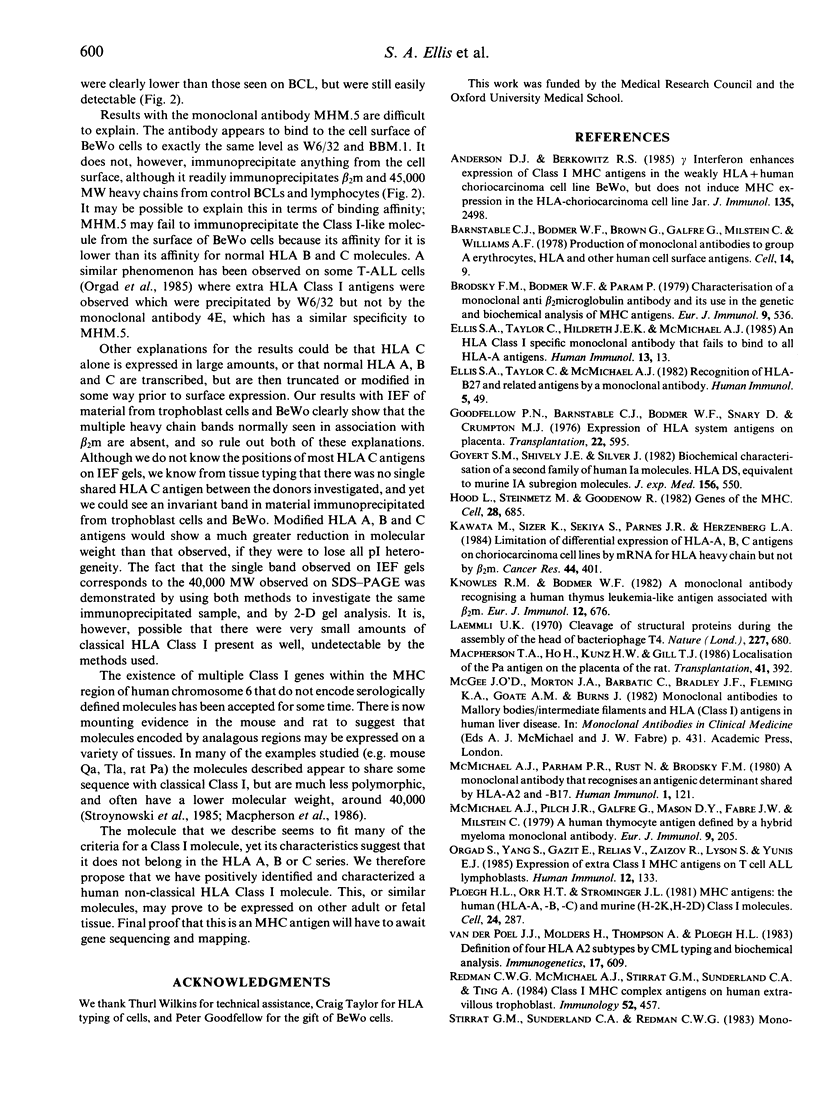Abstract
We describe the characterization of a novel HLA Class I molecule, which we have isolated from chorionic cytotrophoblast cell membranes, and from a trophoblast-derived choriocarcinoma cell line, BeWo; classical HLA Class I antigens are not expressed on these cells. This antigen is an electrophoretically non-polymorphic glycoprotein of approximately 40,000 molecular weight, which is found in association with beta 2 microglobulin, and which is detected by monoclonal antibodies recognizing monomorphic determinants of HLA Class I. Elucidation of the nature and origin of this molecule may provide valuable information regarding the immune barrier that exists between mother and fetus.
Full text
PDF






Images in this article
Selected References
These references are in PubMed. This may not be the complete list of references from this article.
- Anderson D. J., Berkowitz R. S. Gamma-interferon enhances expression of Class I MHC antigens in the weakly HLA+ human choriocarcinoma cell line BeWo, but does not induce MHC expression in the HLA- choriocarcinoma cell line Jar. J Immunol. 1985 Oct;135(4):2498–2501. [PubMed] [Google Scholar]
- Brodsky F. M., Bodmer W. F., Parham P. Characterization of a monoclonal anti-beta 2-microglobulin antibody and its use in the genetic and biochemical analysis of major histocompatibility antigens. Eur J Immunol. 1979 Jul;9(7):536–545. doi: 10.1002/eji.1830090709. [DOI] [PubMed] [Google Scholar]
- Ellis S. A., Taylor C., Hildreth J. E., McMichael A. J. An HLA class I specific monoclonal antibody that fails to bind to all HLA-A antigens. Hum Immunol. 1985 May;13(1):13–19. doi: 10.1016/0198-8859(85)90023-0. [DOI] [PubMed] [Google Scholar]
- Ellis S. A., Taylor C., McMichael A. Recognition of HLA-B27 and related antigen by a monoclonal antibody. Hum Immunol. 1982 Aug;5(1):49–59. doi: 10.1016/0198-8859(82)90030-1. [DOI] [PubMed] [Google Scholar]
- Goodfellow P. N., Barnstable C. J., Bodmer W. F., Snary D., Crumpton M. J. Expression of HLA system antigens on placenta. Transplantation. 1976 Dec;22(6):595–603. doi: 10.1097/00007890-197612000-00009. [DOI] [PubMed] [Google Scholar]
- Goyert S. M., Shively J. E., Silver J. Biochemical characterization of a second family of human Ia molecules, HLA-DS, equivalent to murine I-A subregion molecules. J Exp Med. 1982 Aug 1;156(2):550–566. doi: 10.1084/jem.156.2.550. [DOI] [PMC free article] [PubMed] [Google Scholar]
- Hood L., Steinmetz M., Goodenow R. Genes of the major histocompatibility complex. Cell. 1982 Apr;28(4):685–687. doi: 10.1016/0092-8674(82)90046-0. [DOI] [PubMed] [Google Scholar]
- Knowles R. W., Bodmer W. F. A monoclonal antibody recognizing a human thymus leukemia-like antigen associated with beta 2-microglobulin. Eur J Immunol. 1982 Aug;12(8):676–681. doi: 10.1002/eji.1830120810. [DOI] [PubMed] [Google Scholar]
- Laemmli U. K. Cleavage of structural proteins during the assembly of the head of bacteriophage T4. Nature. 1970 Aug 15;227(5259):680–685. doi: 10.1038/227680a0. [DOI] [PubMed] [Google Scholar]
- Macpherson T. A., Ho H. N., Kunz H. W., Gill T. J., 3rd Localization of the Pa antigen on the placenta of the rat. Transplantation. 1986 Mar;41(3):392–394. doi: 10.1097/00007890-198603000-00022. [DOI] [PubMed] [Google Scholar]
- McMichael A. J., Parham P., Rust N., Brodsky F. A monoclonal antibody that recognizes an antigenic determinant shared by HLA A2 and B17. Hum Immunol. 1980 Sep;1(2):121–129. doi: 10.1016/0198-8859(80)90099-3. [DOI] [PubMed] [Google Scholar]
- McMichael A. J., Pilch J. R., Galfré G., Mason D. Y., Fabre J. W., Milstein C. A human thymocyte antigen defined by a hybrid myeloma monoclonal antibody. Eur J Immunol. 1979 Mar;9(3):205–210. doi: 10.1002/eji.1830090307. [DOI] [PubMed] [Google Scholar]
- Orgad S., Yang S. Y., Gazit E., Relias V., Zaizov R., Lyson S., Yunis E. J. Expression of extra class I major histocompatibility antigens on T-cell acute lymphoblastic leukemia (ALL) lymphoblasts. Hum Immunol. 1985 Mar;12(3):133–141. doi: 10.1016/0198-8859(85)90331-3. [DOI] [PubMed] [Google Scholar]
- Ploegh H. L., Orr H. T., Strominger J. L. Major histocompatibility antigens: the human (HLA-A, -B, -C) and murine (H-2K, H-2D) class I molecules. Cell. 1981 May;24(2):287–299. doi: 10.1016/0092-8674(81)90318-4. [DOI] [PubMed] [Google Scholar]
- Redman C. W., McMichael A. J., Stirrat G. M., Sunderland C. A., Ting A. Class 1 major histocompatibility complex antigens on human extra-villous trophoblast. Immunology. 1984 Jul;52(3):457–468. [PMC free article] [PubMed] [Google Scholar]
- Schumm D. E., Hanausek-Walaszek M. E., Walaszek Z., Webb T. E. Absence of the cancer-associated factor with a molecular weight of 60,000 from the plasma of patients with a spectrum of nonneoplastic conditions. Cancer Res. 1984 Jan;44(1):401–406. [PubMed] [Google Scholar]
- Stroynowski I., Forman J., Goodenow R. S., Schiffer S. G., McMillan M., Sharrow S. O., Sachs D. H., Hood L. Expression and T cell recognition of hybrid antigens with amino-terminal domains encoded by Qa-2 region of major histocompatibility complex and carboxyl termini of transplantation antigens. J Exp Med. 1985 May 1;161(5):935–952. doi: 10.1084/jem.161.5.935. [DOI] [PMC free article] [PubMed] [Google Scholar]
- van der Poel J. J., Mölders H., Thompson A., Ploegh H. L. Definition of four HLA-A2 subtypes by CML typing and biochemical analysis. Immunogenetics. 1983;17(6):609–621. doi: 10.1007/BF00366129. [DOI] [PubMed] [Google Scholar]




